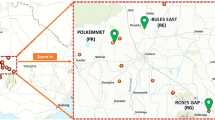Abstract
Using recycled materials in pavement applications is a viable option to reduce costs and limit the environmental impact of road construction. During the past decades, many agencies in the U.S. have investigated the effect on pavement performance of adding Reclaimed Asphalt Pavement (RAP), and, more recently, Recycled Asphalt Shingles (RAS) to asphalt mixtures, and limits were proposed on the amount of recycled materials which can be used. This paper investigates the effect of adding both RAP and RAS to virgin asphalt mixtures by means of a simple low temperature creep test performed on asphalt mixture beams. From the experimental work, creep stiffness, m-value, thermal stress and critical cracking temperature are calculated and compared statistically and graphically. Based on the results, it is concluded that most of the mixtures prepared with combinations of RAP and RAS perform similarly to standard mixtures at low temperature. For a limited number of mixtures, a negative effect is observed.
Similar content being viewed by others
References
AASHTO T 313-02 (2006). “Determining the flexural creep stiffness of asphalt binder using the Bending Beam Rheometer (BBR).” American Association of State Highway and Transportation Officials (AASHTO).
Basu, A. (2002). An evaluation of the Time-Temperature equivalence factor and of the physical hardening effects on low temperature asphalt binder specifications, MSc Thesis, University of Minnesota, USA.
Basu, A., Marasteanu, O. M., and Hesp, S. (2003). “Time-Temperature superposition and physical hardening effects in low temperature asphalt binder grading.” Transportation Research Record (TRR), Journal of the Transportation Research Board (TRB), Vol. 1829, pp. 1–7.
Burak, S. and Ali, T. (2005). “Use of asphalt roofing shingle waste in HMA.” Construction and Building Materials, Vol. 19, Issue 5, pp. 337–346.
Button, J. W., Williams, D., and Sherocman, J. A. (1996). Roofing Shingles and toner in asphalt pavements, FHWA Research Report, FHWA/TX-96/1344-2F, Texas Transportation Institute.
Cook, R. Dennis and Weisberg, S. (1999). Applied regression including computing and graphics, Wiley Series in Probability and Statistics, USA.
Dannhausen, W. O. (1997). “Recycling alternatives studied and tried.” Better Roads, Vol. 67, Issue 3, pp. 25–26.
Foo, K. Y., Hanson, D. I., and Lynn, T. A. (1999). “Evaluation of roofing shingles in hot mix asphalt.” Journal of Materials in Civil Engineering, American Society of Civil Engineers, ASCE, Vol. 11, Issue 1, pp. 15–50.
Hansen, K., Newcomb, D., and Cervarich, M. (2011). “Asphalt tops the charts for environmental stewardship-again.” Asphalt Pavement Magazine, National Asphalt Pavement Association (NAPA), Vol. 16, pp. 20–25.
Hopkins, I. L. and Hamming, R. W. (1967). “On creep and relaxation.” Journal of Applied Physics, Vol. 28, Issue 8, pp. 906–909.
Johnson, E., Johnson, G., Dai, S., Linell, D., McGraw, J., and Watson, M. (2010). Incorporation of recycled asphalt shingles in hot-mixed asphalt pavement mixtures, Final Report MN/RC 2010-08, Minnesota Department of Transportation (MN/DOT).
Li, X., Marasteanu, M. O., Williams, R. C., and Clyne, T. R. (2008). “Effect of reclaimed asphalt pavement (proportion and type) and binder grade on asphalt mixtures.” Transportation Research Record (TRR), Journal of the Transportation Research Board (TRB), Vol. 2051, pp. 90–97.
Little, D. H., Holmgreen, R. J., and Epps, J. A. (1981). “Effect of recycling agents on the structural performance of recycled asphalt concrete materials.” Journal of the Association of Asphalt Paving Technologists (AAPT), Vol. 50, pp. 32–63.
Marasteanu, O. M. and Anderson, D. A. (1999). “Improved Model for Bitumen Rheological Characterization.” Presented at: European Workshop on Performance-Related Properties for Bituminous Binders, Luxembourg, Belgium.
Marasteanu, M. O., Velasquez, R., Zofka, A., and Cannone Falchetto, A. (2009). Development of a simple test to determine the low temperature creep compliance of asphalt mixtures, NCHRP IDEA Report 133.
Marks V. J. and Petermeier, G., (1997), Let me shingle your roadway, Interim Report for Iowa DOT Research Project HR-2079, Iowa Department of Transportation (Iowa/DOT), pp. 54–57.
McDaniel, R. S., Soleymani, H., Anderson, R. M., Turner, P., and Peterson, R. (2000). Recommended use of Reclaimed asphalt pavement in the super-pave mix design method, NCHRP Web Document 30 (Project D9-12): Contractor’s Final Report, Transportation Research Board (TRB), National Research Council, Washington, D.C.
McGraw, J., Zofka, A., Krivit, D., Schroer, J, Olson, R., and Marasteanu, M. O. (2007). “Recycled asphalt shingles in hot mix asphalt.” Journal of Association of Asphalt Paving Technologists (AAPT), Vol. 76, pp. 235–274.
McNichol, D. (2005). Paving the way: Asphalt in America, National Asphalt Association, Lanham, Maryland 〈http://bit.ly/rJ5UVs〉.
Minnesota Department of Transportation (MN/DOT) (2008). Combined 2350/2360 plant mixed asphalt pavement, standard specifications for construction, Minnesota Department of Transportation (MN/DOT).
Minnesota Department of Transportation (MN/DOT) (2010). Tear-Off scrap asphalt shingles specification 2360, Office of Materials, Minnesota Department of Transportation (MN/DOT).
Moon, K. H. (2010). Comparison of thermal stresses calculated from asphalt binder and asphalt mixture creep compliance Data, MSc Thesis, University of Minnesota, USA.
National Cooperative Highway Research Program (NCHRP) (2001). Recommended use of reclaimed asphalt pavement in the superpave mix design method: Guidelines, Research Results Digest 253.
National Cooperative Highway Research Program (NCHRP) (2001). Recommended use of reclaimed asphalt pavement in the superpave mix design method: Technician’s manual, Transportation Research Board, Report 452.
Newcomb, D. E., Stroup-Gardiner, M., Weikle, B., and Drescher, A. (1993). Influence of roofing shingles on asphalt concrete mixture properties, final report, No. MN/RC-93-09, Minnesota Department of Transportation (MN/DOT), St. Paul, Minnesota, USA.
Shenoy, A. (2002). “Single-event cracking temperature of asphalt pavements directly from the Bending Beam Rheometer (BBR) Data.” Journal of Transportation Engineering, American Society of Civil Engineers, ASCE, Vol. 128, Issue 5, pp. 465–471.
Author information
Authors and Affiliations
Corresponding author
Rights and permissions
About this article
Cite this article
Moon, K.H., Falchetto, A.C., Marasteanu, M. et al. Using recycled asphalt materials as an alternative material source in asphalt pavements. KSCE J Civ Eng 18, 149–159 (2014). https://doi.org/10.1007/s12205-014-0211-1
Received:
Accepted:
Published:
Issue Date:
DOI: https://doi.org/10.1007/s12205-014-0211-1




